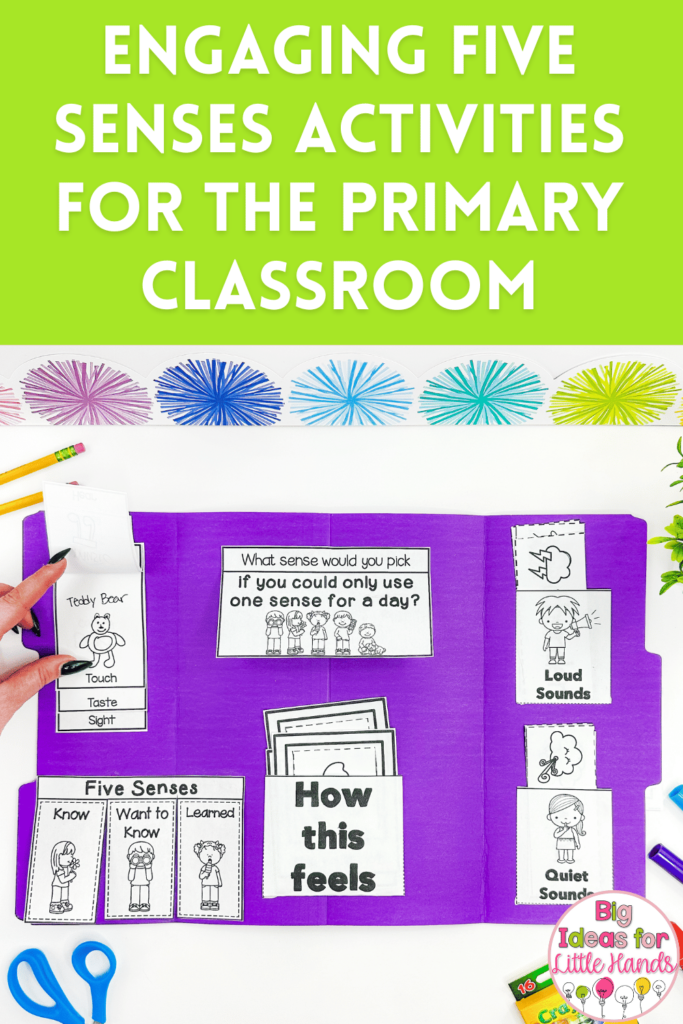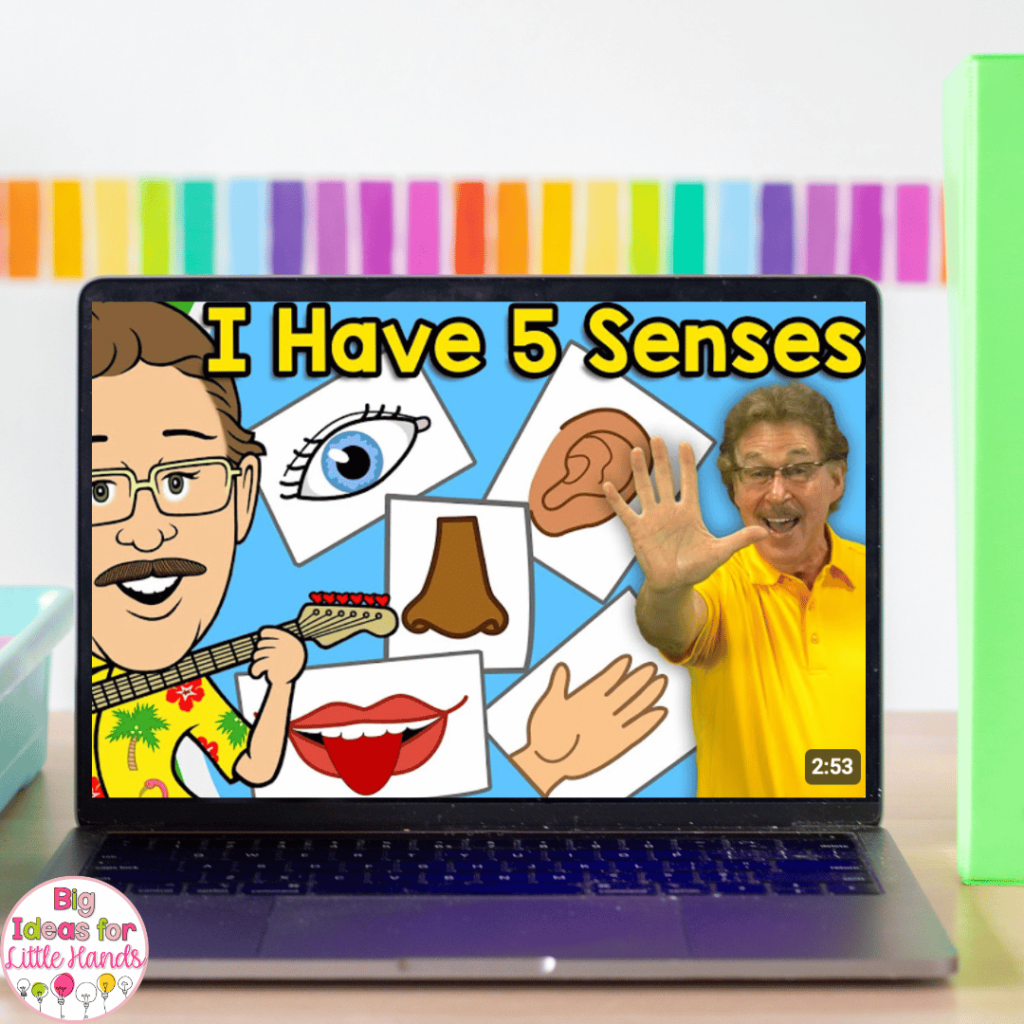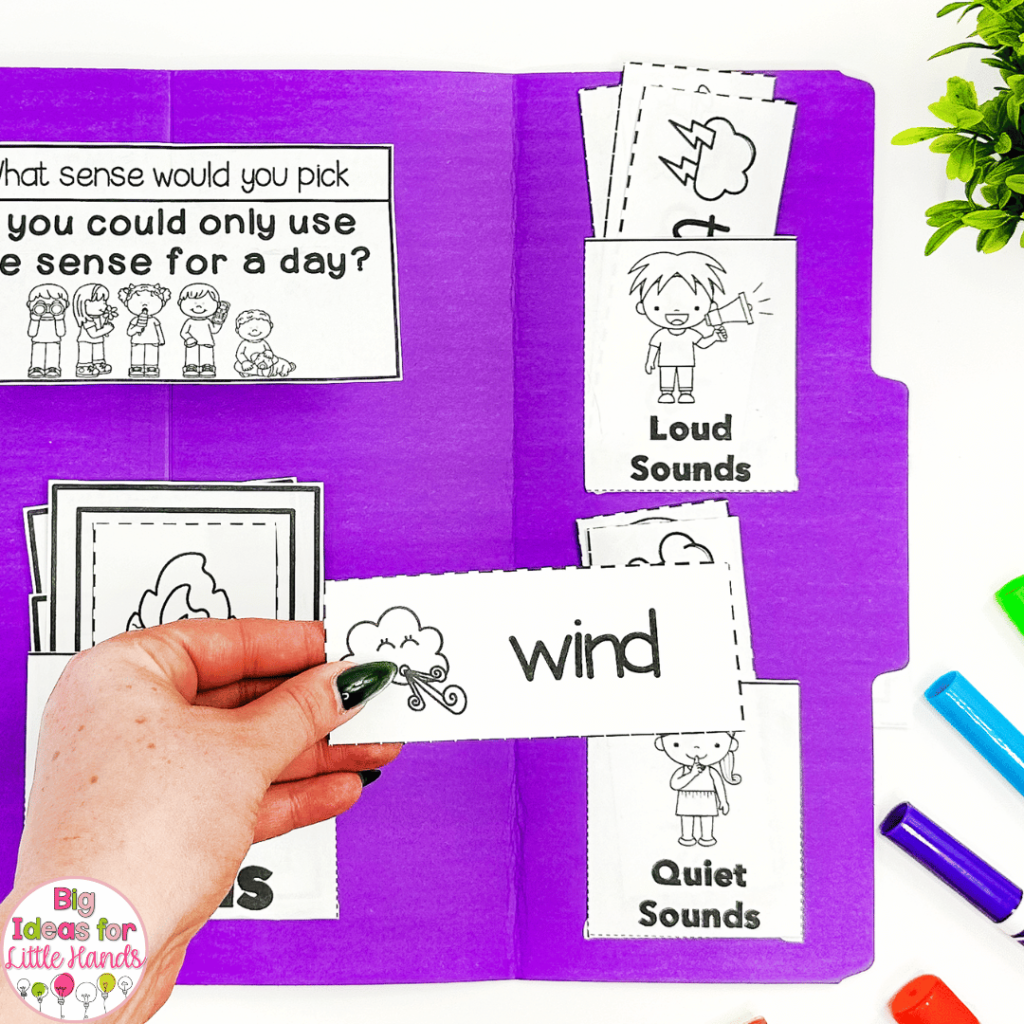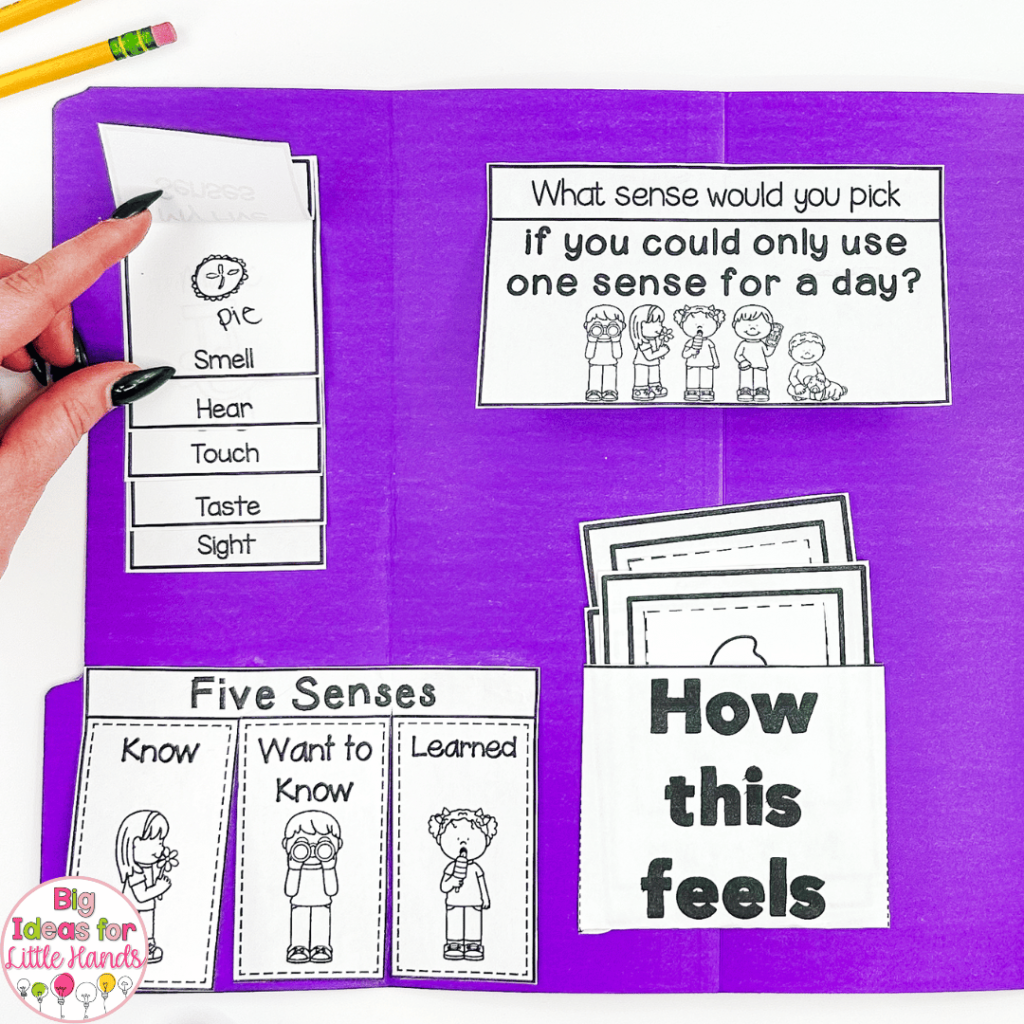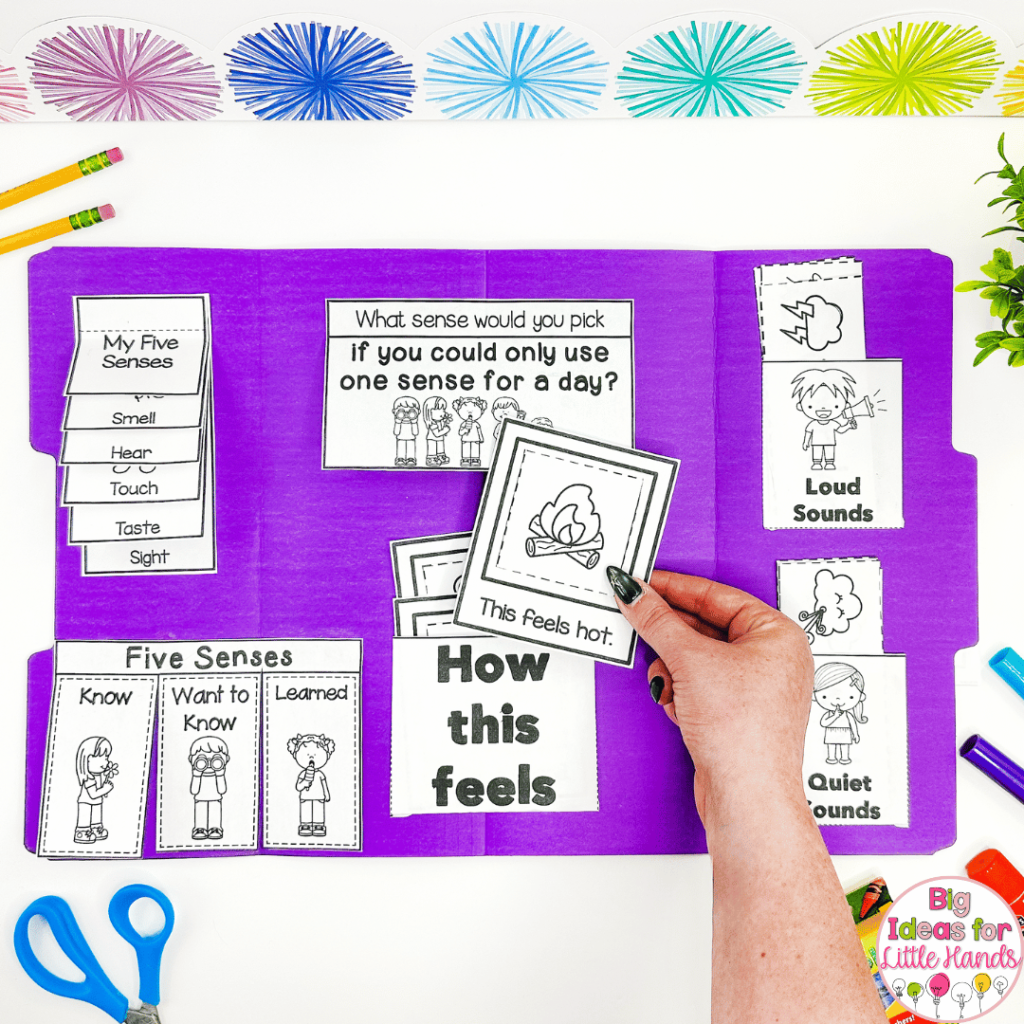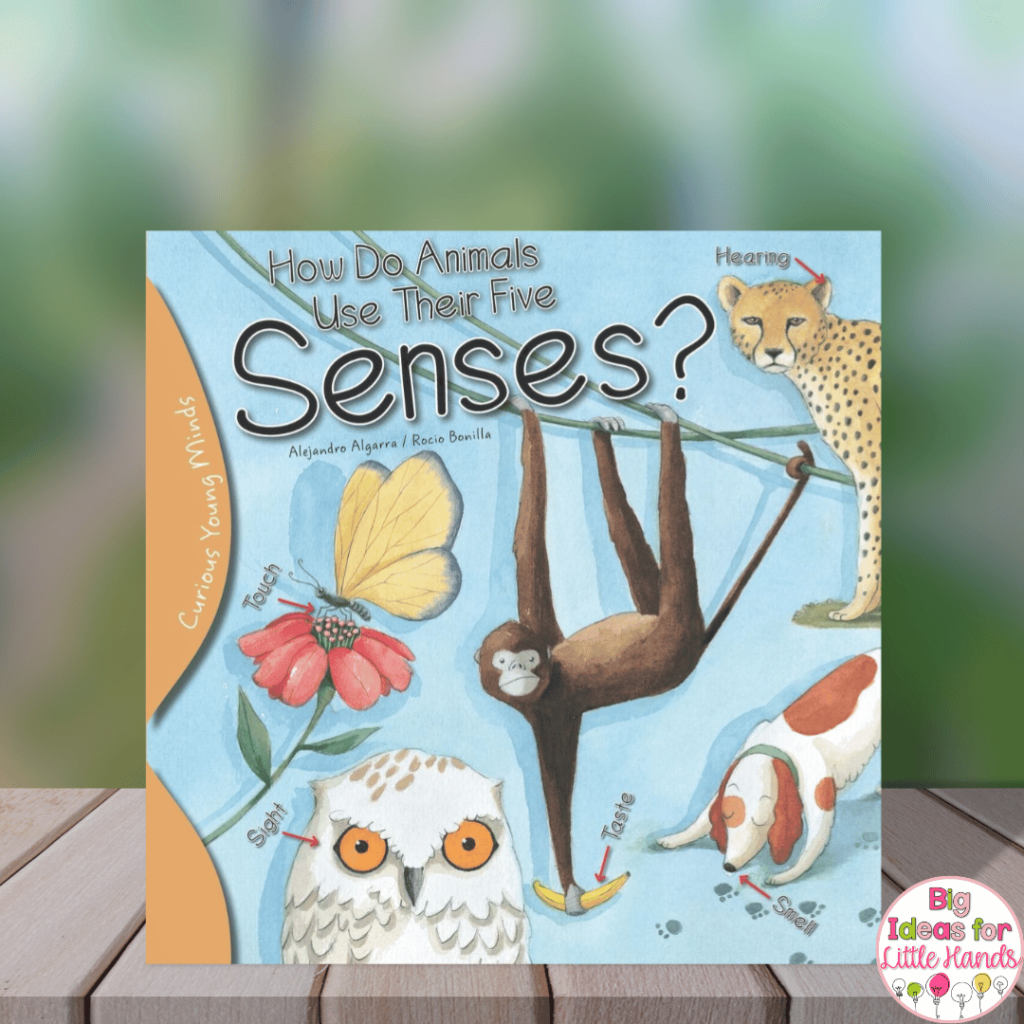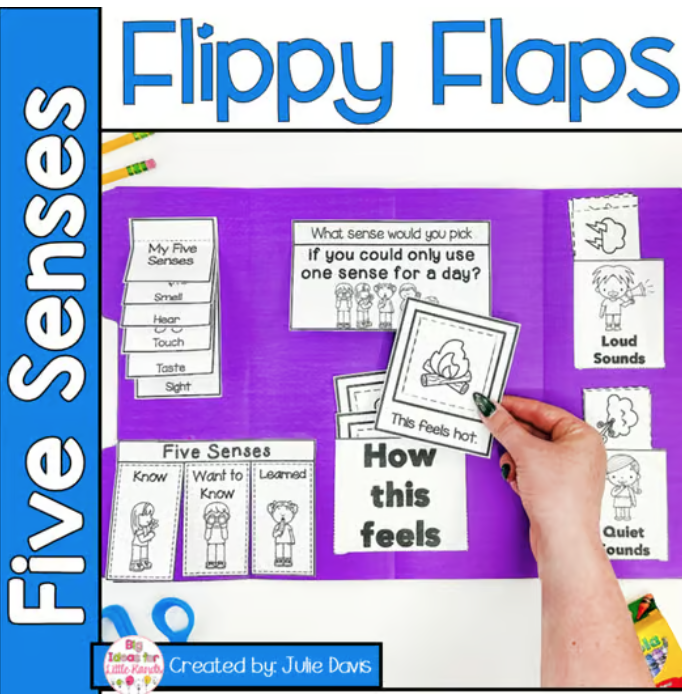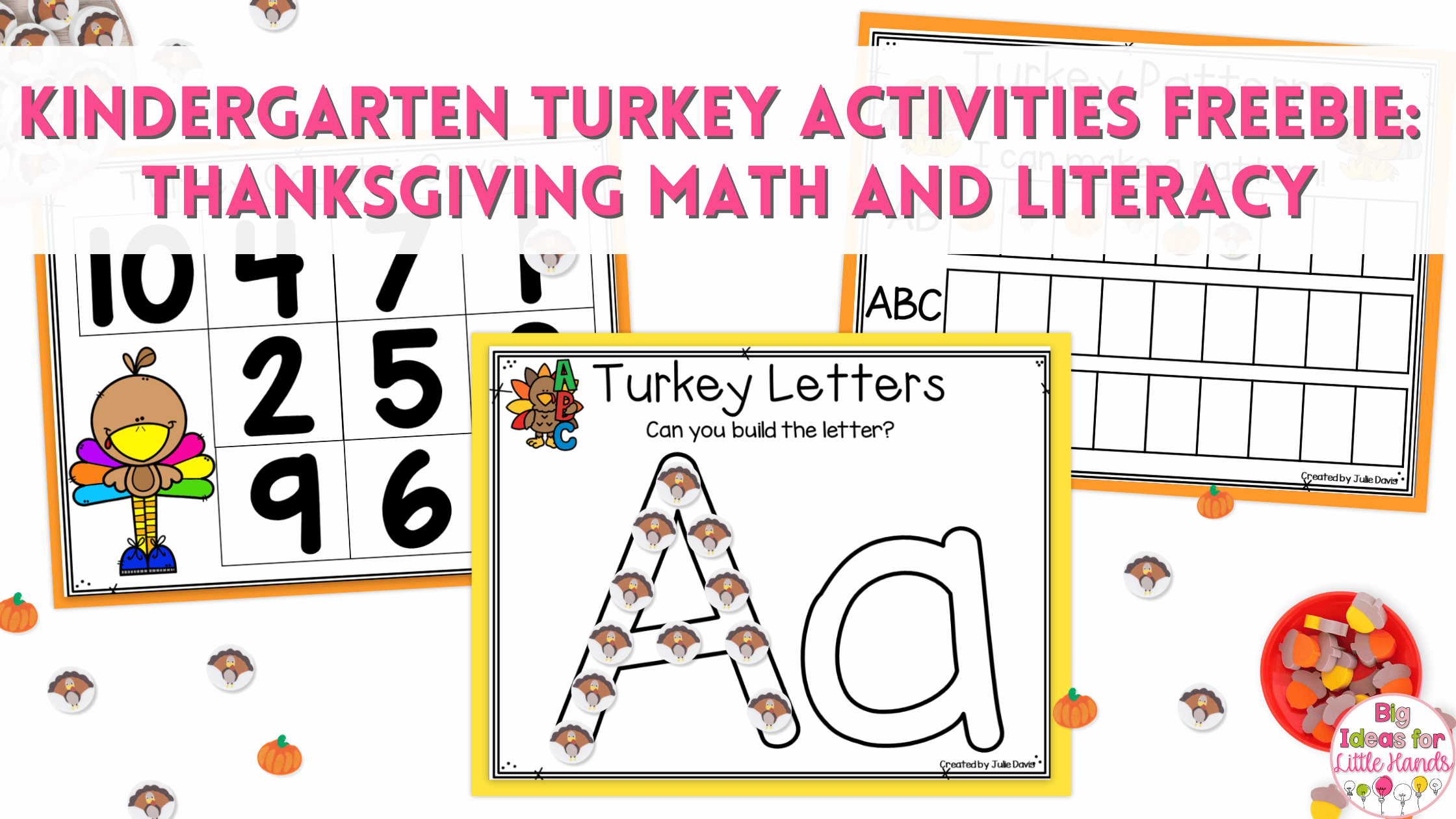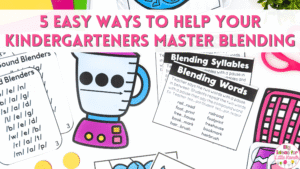As a primary teacher, teaching about the five senses is a must! It’s such a wonderful science topic that helps our little learners explore more about themselves and the world around them. I love teaching this topic at the beginning of the school year because we refer back to it often. But it is a great unit to teach any time of the year! In this post, I’m sharing my seven-day plan filled with engaging, hands-on activities that have helped my students get excited about the five senses.
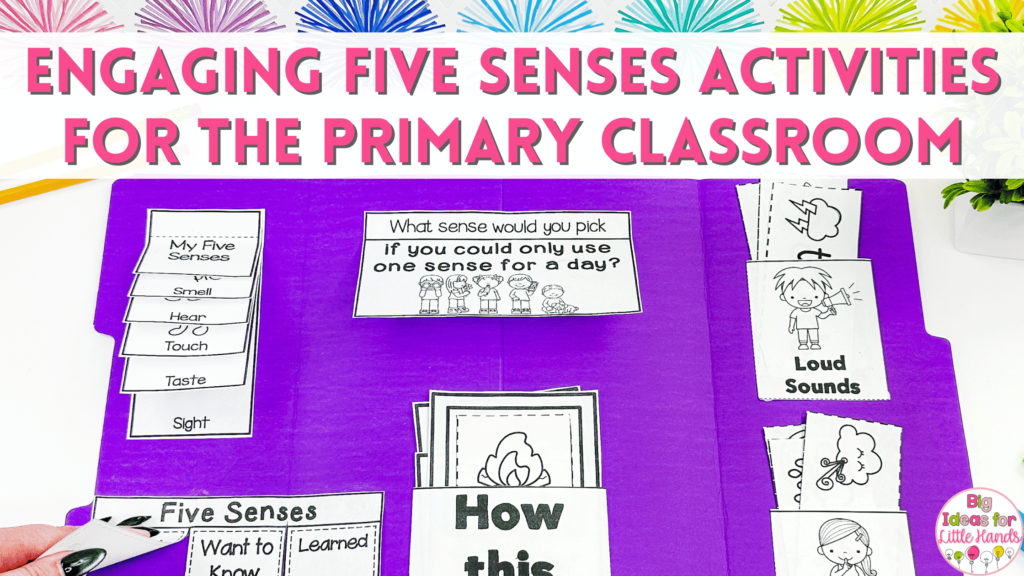
What are the Five Senses
The “five senses” refer to the five different avenues that we, as humans, take in information. We use our five senses every single day, often without even realizing it. It is because of our five senses that we can communicate, interact, and be aware of our surroundings.
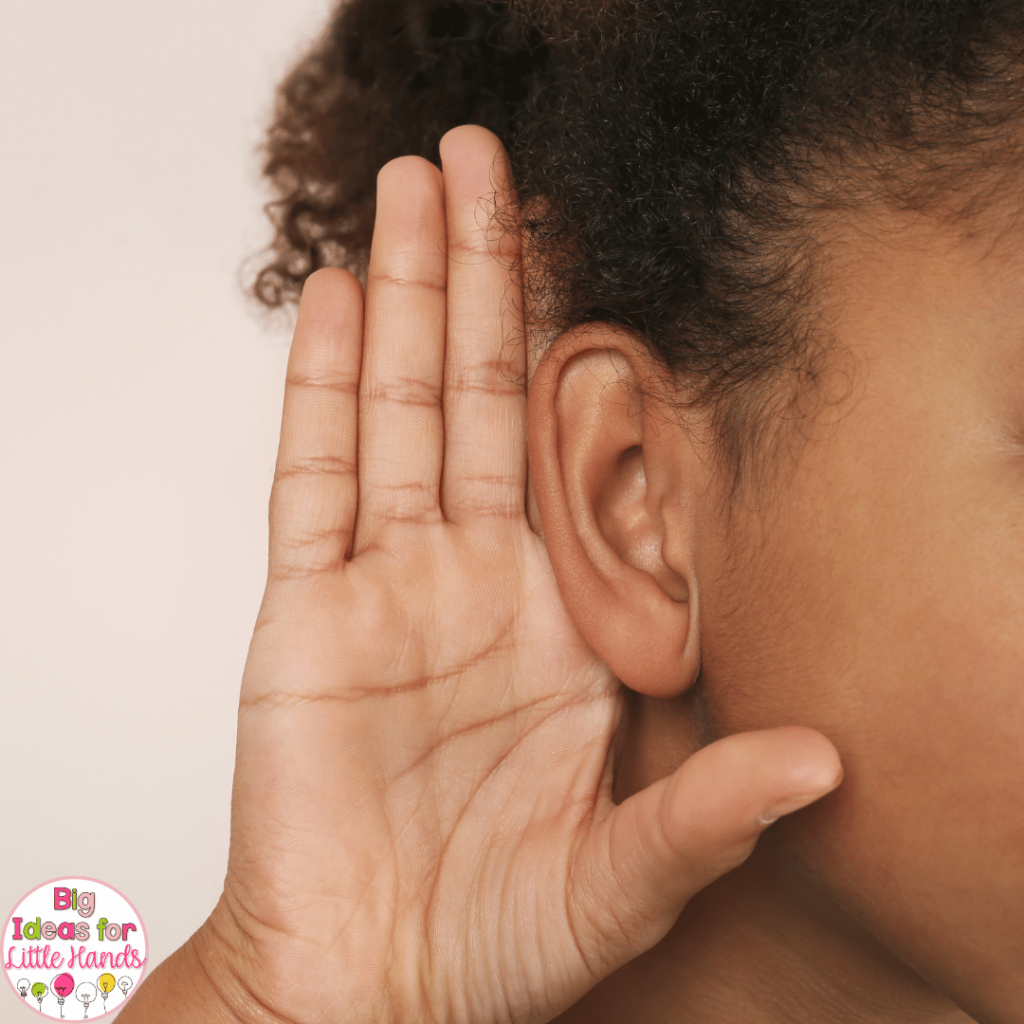
The five senses include:
- Sight: all the things that we see using our eyes. The information we take in through our eyes is vast. It is so much more than just identifying objects. Through our sense of sight, we can see color, size, and texture, read body language, and detect movement!
- Hearing: the sense of hearing includes all the things that we hear with our ears. Hearing allows us to communicate, enjoy things like music, and hear noises in our environment. The sounds we hear can help us determine if someone or something is friendly or if danger is nearby.
- Smell: the sense of smell allows us to detect and identify different odors using our nose. Our sense of smell does so much more than let us know when dinner is ready. It also plays a key role in taste perception and memory recall.
- Taste: the sense of taste helps us distinguish flavors such as sweet, salty, sour, bitter, and umami using taste buds on our tongue. It influences our food preferences and eating habits.
- Touch: the sense of touch allows us to feel textures, temperature, and pressure through nerve endings in our skin. It helps us interact with our environment and perceive physical sensations.
While our students see, hear, taste, smell, and touch every day, many don’t have the background knowledge to connect those actions with the five senses. In this unit, students will learn not only the why and how of the five senses but also just how important each of these senses is.
Teaching the Five Senses
In my classroom, I like to introduce the topic and find out what students already know on day one. Then, it’s time to dive into each of the senses individually. In my classroom, we focus on one sense each day. This allows us to really focus on what the sense is, what part of the body is connected with the sense, and just how magically the sense helps us understand our world. We wrap up our unit with an extension activity that helps us pull everything together.
Keep reading to find out what each day looks like as I teach about the five senses!
Day 1: Introducing the Five Senses
Any time I start a new unit, I love to introduce the topic to students in a fun and engaging way. A quick video, like this one that my students love, is a surefire way to grab your students’ attention and keep them engaged while introducing a new topic.
Books are also a great way to introduce topics to young learners. On the first day of the unit, I love to do a science-based read-aloud that gives a nice overview of the topic. The Five Senses by Jennifer Prior is a perfect book for day one.
After our video and book, I introduce students to our Five Senses Lapbook. This is going to be a tool that we use throughout our study. I love using lapbooks because they are such a great way to collect learning activities. We build out the lapbook as we work our way through the unit, and in the end, we have a wonderful keepsake of the topic. Think of it as an interactive notebook, except it only covers the five senses.
On the first day, we set up our lapbooks and create our covers. We talk about why we are adding a picture of an eye, nose, ear, mouth, and hand to the cover. This is a great way for students to connect what they learned in the video and book to our topic.
Over the next few days, we will dive into each of the senses individually. This gives us the chance to really explore the senses through hands-on activities and our lapbook.
Day 2: Sense of Sight
On day two, we are exploring the sense of sight. We begin with a discussion of what sight is and how it is important to our daily lives. During our discussion, I make sure to point out the properties we can see using our sense of sight. Things like color, size, shape, and texture are all examples.
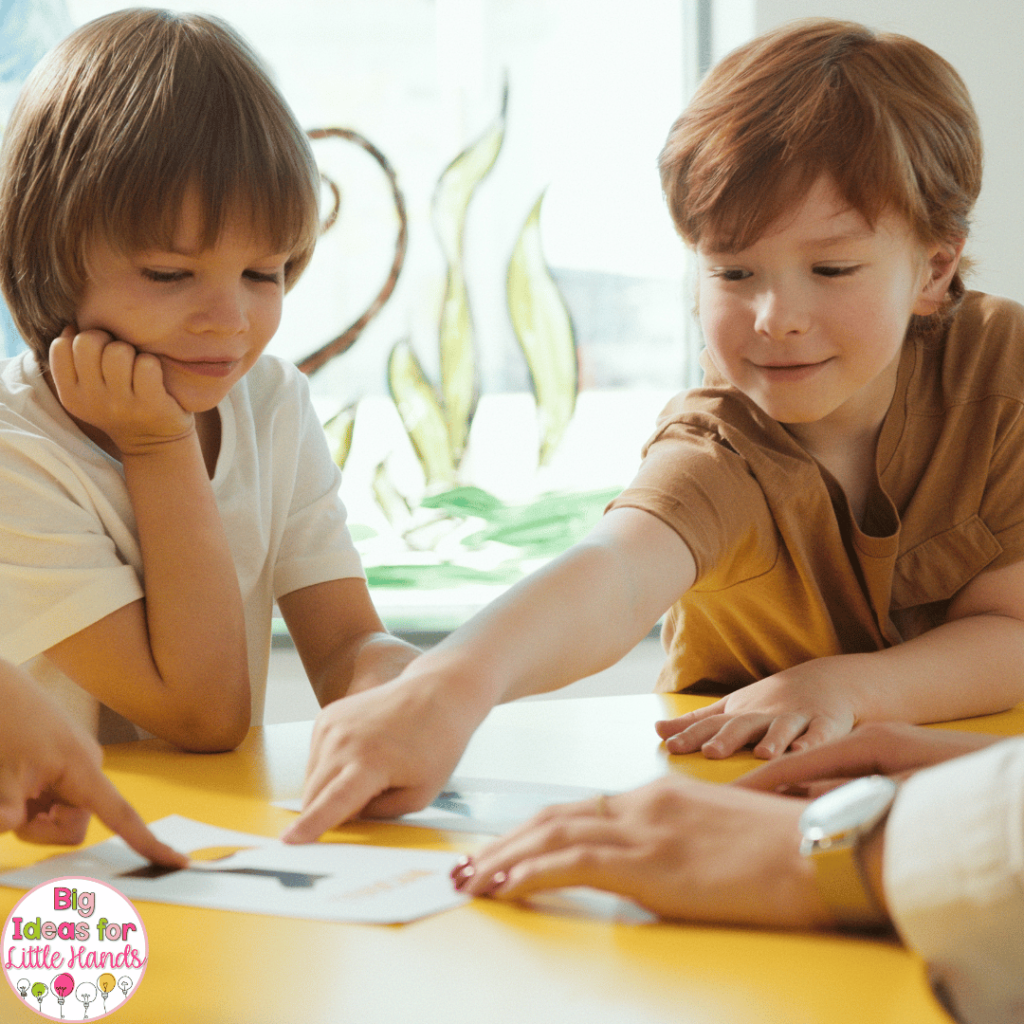
I love to play I Spy as we learn about the sense of sight and the properties we can see. I start by choosing an object in the classroom and then describe it using my sense of sight. Between each clue, I let a few students take a guess. I continue to add clues until a student guesses correctly. After this, we talk briefly about what properties were used as clues and how each clue was things that we see. Then we break up into partners and play 2 more times. This way, everyone has a chance to choose an item and be a guesser.
Then it is off to add to our lapbooks. On this day, we put together the “All About the Five Senses” mini tab book. I like to have students cut out all the pages so that we can staple them together before we glue the book into our lapbook. Then we complete the page on sight.
We finish up with a game of “What’s Missing?” To play this game, I grab 5-6 random items from the classroom and put them on a tray. I show my students the items for about 5 seconds, and then I cover the tray with a towel. I secretly remove one item from the tray and then reveal the tray and ask my students what is missing. The kids love playing this game! We gradually make the game a little harder by shortening the time or removing multiple items. You can even take all the items off and have the students put them back in the same order.
Not only is this a fun visual game that reinforces the importance of our sense of sight, but it is great for working on visual discrimination and critical thinking skills too!
Day 3: Sense of Hearing
We kick off day three with one of my favorite read-alouds of the unit, I Hear a Pickle by Rachel Isadora. This is such a fun book that dives into the things we can hear and cannot hear, as well as using the other senses.
During our mini-lesson on the sense of hearing, we learn that our ears are the body parts that are responsible for hearing sounds. We talk about lots of different sounds that we hear every day, and then we sort them on an anchor chart. Students love sharing something that makes a sound and telling whether it is loud or quiet.
Inside our lapbooks, we create the loud sounds and the quiet sounds sorting pockets. I give students a chance to color and cut the pockets and sorting cards, and then we add them to our lapbooks. To wrap up this activity, we sort the cards together. I love that some of the items can be both loud and quiet. It gives us a chance to discuss how sounds can change.
To finish up our sense of hearing day, we head outside with a clipboard, a piece of paper, and a pencil for some Sound Art. We find a place where we can all sit down, and then I tell students we are going to draw. But here’s the catch: they can only draw something that they hear! I like to begin by having a couple of minutes of just listening. We listen to the sounds of the world around us. It’s amazing how quiet the kids will get when they are tasked with listening for sounds. After a couple of minutes, I have them draw something that they heard.
Day 4: Sense of Smell
On day four, we dive into learning about the sense of smell. This one is so much fun! I love to begin by brainstorming a list of things that we can smell. It’s amazing to listen to the great descriptions students give about things so small. Unless it is something universal like ‘pizza’, their items rarely use one word. Instead, you get things like ‘my big brother’s stinky socks’ or ‘my grandma’s house when she makes cookies.’ We also talk about whether these things smell good or bad.
Next up, it is time for our Mystery Smells Activity. In preparation for this activity, I gather a variety of objects that have a strong smell. I like to put each one in a brown paper sack that I staple closed. Items I like to use in the bags include a lemon, a cotton ball with some vanilla on it, a sardine or other type of fish (actual fish or a rag with some of the juice), some smelly cheese, something chocolate, and something floral or herby. There are limitless amounts of smells you can gather for this activity.
Once I have all the smells inside a bag, we try to guess what is inside. With the bag folded over and stapled shut, I cut a small hole near the top. It makes the perfect size for little noses to get a whiff of what is inside. We pass the bag around and let each person take a sniff. Then, I have them write or draw what they think is inside. After the bag has made it around the circle, we take a few guesses before revealing the item.
We finish up this day by creating the five senses flip book for our lapbook. Once we have the book put together, we head over to the smell page and add a picture of our favorite smell.
Day 5: Sense of Taste
If ever there is a day that the kids are really excited for, it is the sense of taste. They know that there is a good chance that we will be tasting things, and they aren’t wrong! There’s no better way to learn about the sense of taste than with a taste test!
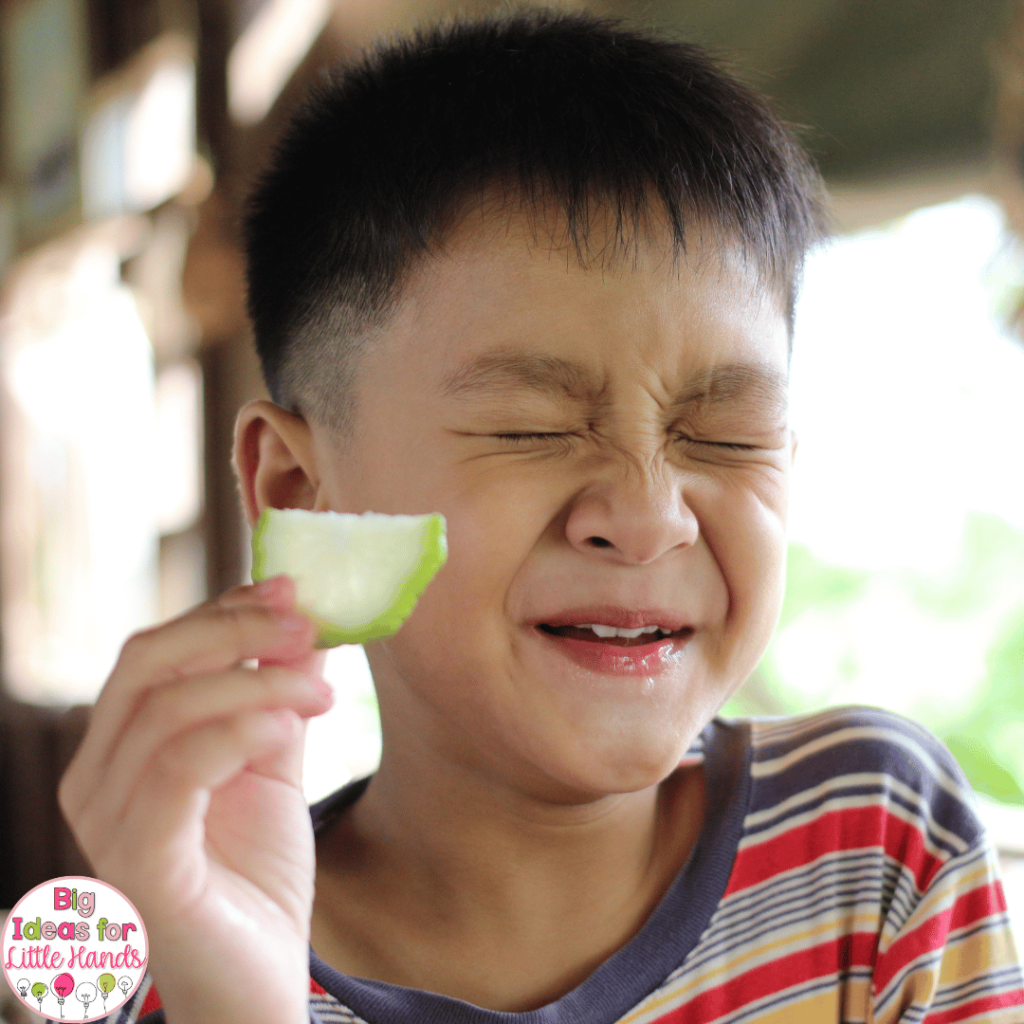
Before we start, I let students know that they are not required to eat anything they don’t want to eat. But I do encourage them to try everything, even if it is a really small bite. We also talk about the appropriate way to dispose of something we don’t like by using a napkin. And yes, I model what this looks like and have them practice. Laying the expectations for this activity will help it to go much more smoothly, as there are sure to be students who don’t like some of the flavors we explore.
In our taste test, I try to include a variety of items that help them learn about sweet, sour, salty, and bitter. Since it is a taste test and not a meal or snack, each student needs only a small amount of each item. These are the items I like to include in our taste test: a sweet red apple, a sour green apple, lemon or lime, a salt & vinegar potato chip, baking chocolate (very small pieces), a small piece of a strong cheese, and a piece of flavored beef jerky.
We taste each item together and talk about the flavor. I make sure to use the words sweet, sour, salty, and bitter as I am talking to help students learn these vocabulary words. We also take a poll to see who liked each item and who didn’t. At the very end, we build a graph to show the favorite item eaten, and I let each student come up and color in a square of the graph for their favorite taste.
Then we pull out our lapbooks and create the Sense of Taste foldable. Students will then use what they learned about the four flavors to complete the activity by cutting and pasting pictures of food items into the correct category.
Day 6: Sense of Touch
We kick off day six by exploring our sense of touch! I love starting with a discussion about what we can feel with our hands and skin. We brainstorm a list of textures and temperatures, and I guide students to describe how things feel using words like rough, smooth, bumpy, soft, hard, warm, and cold.
Next, we dive into a Mystery Bag Touch Test. I gather several objects with distinct textures and place them inside individual brown paper bags or pillowcases. Students take turns reaching inside (without looking!) and using only their sense of touch to describe what they feel. After they’ve made their guesses, we reveal each item and discuss how texture helps us recognize objects.
Then it’s time for a Texture Hunt! I hand out small squares of paper and let students move around the classroom, searching for different textures. When they find something interesting, they do a texture rubbing by placing the paper over the object and using the side of a crayon to make an imprint. Once everyone has a few rubbings, we come together to share what we found.
We then pull out our lapbooks and create the “How This Feels” pocket. Students will cut out and color the pictures and match them with the cards that describe how items feel. Once they are done, they will tuck all the cards away inside the pocket that has been glued into their lapbook. It’s the perfect activity to pull together all of the hands-on learning we did about the sense of touch.
Day 7: The Five Senses Wrap Up
It’s the last day, so we take time to review everything we’ve learned about the five senses. We start by finishing up any of the activities in our lapbook that weren’t completed. Then, we take time to review all the activities we’ve done. It’s amazing how much learning happened in just a few days!
Then, we put our knowledge to the test with a Five Senses Scavenger Hunt! I create a checklist with tasks like:
- Find something that smells sweet.
- Find something that makes a loud sound.
- Find something rough to touch.
- Find something that is red.
- Find something that tastes sour.
Students work in pairs to find items around the classroom, and we share our findings at the end.
To finish up our unit, I read the book How Animals Use Their Five Senses by Alejandro Algarra. This is a great book that helps to expand our thinking about the five senses from humans to animals. The students are always excited to think about animals having senses, and they are amazed to learn how animals use their senses to help them live.
Teaching the Five Senses in Your Classroom
I hope that you have found some fun and engaging ideas that you can use in your classroom. Many of these hands-on activities can be easily recreated just by grabbing a few items. While these activities are great ways to explore the senses, the Five Senses Lapbook is the foundation of this unit.
This lapbook resource is filled with everything you need to create a lapbook for the five senses in your classroom. From teacher directions and example layouts to no-prep pages that just need to be copied, it is all included. Grab this resource in my TPT store and start planning your five senses unit!
Additional Science Resources for Young Learners
If you are looking for more fun science units filled with engaging activities, then check out these posts next:
- Weather Activities for the Primary Classroom
- Engaging Space Activities Your Students Will Love
- 4 Easy Ways to Bring Science into the Literacy Block
Save These Five Senses Activities
Save this to your favorite teacher Pinterest board so you can come back when you need activities for teaching the five senses in your classroom.
